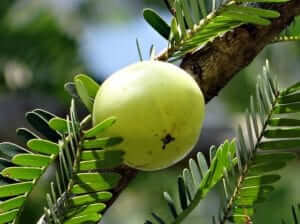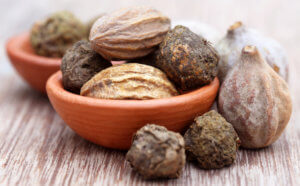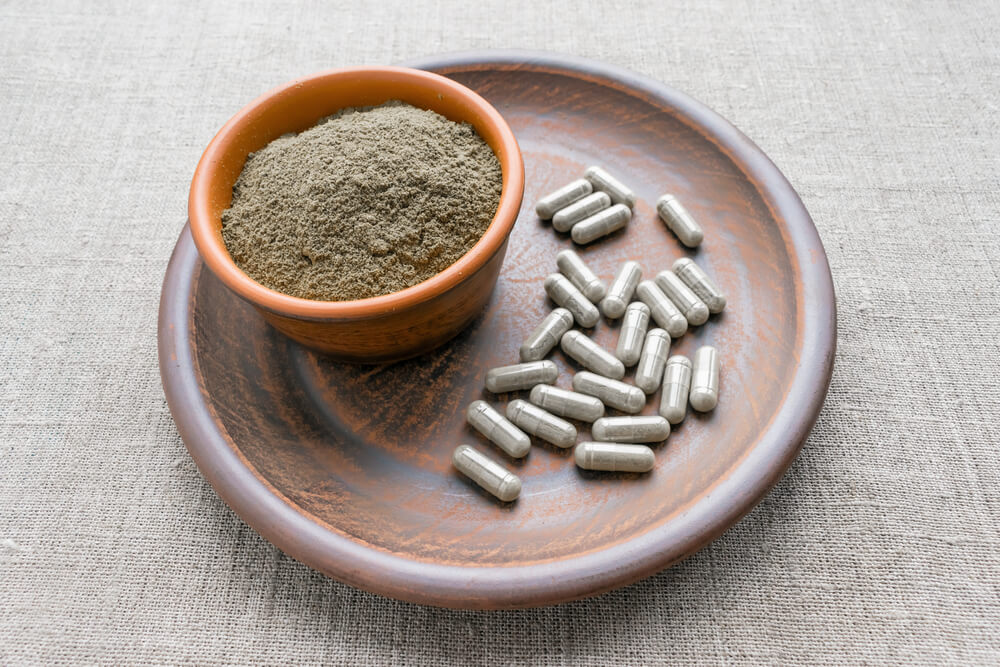Triphala is an ancient herbal preparation that is a staple in Ayurvedic medicine. It is one of the most revered Ayurvedic formulas of all time and is made from a combination of plants all native to India.
Like so many other ancient “remedies”, modern research is now confirming numerous traditional triphala benefits and discovering new potential. This potent botanical formula is full of plant compounds that boost multiple aspects of health, particularly digestion and longevity.
Here’s more about this incredible Ayurvedic formula, its ancient history, and what makes it so powerful.
What is Triphala? A Super-Trio
Triphala (sometimes called triphala churna) is a combination of three fruits all commonly used in Ayurvedic medicine. In fact, the word triphala literally translates to “three fruits” from Sanskrit.
The three fruits— amla (Emblica officinalis), bibhitaki (Terminalia bellerica), and haritaki (Terminalia chebula)— are all dried and ground into a powder to make triphala. The powder is considered to be tridoshic, meaning helpful for each of the three dosha constitutions in Ayurveda, and has five of the six tastes (lacking only saltiness).
These three fruits work synergistically to give triphala more potency than any of them taken separately. However, since most of us aren’t familiar with Ayurvedic herbs, it can be helpful to look at each fruit individually to get an idea of triphala’s benefits as a whole.
Amla (Indian Gooseberry)

Amla is a small, sour fruit that grows natively in southeast Asia. It has a berry-like appearance, yellow-green color, and strong flavor (sometimes described as tart and bitter).
In Ayurveda, amla is a valuable rejuvenator and used to promote longevity, balance the immune system, and cool the pitta dosha. One of its most outstanding characteristics is the high amount of vitamin C it contains— up to 20-30 times the amount found in oranges!
Amla is also very high in antioxidants. It has an ORAC value of 261,500, putting it in the top five list of the highest antioxidant-rich foods on earth.
Studies have already revealed multiple benefits of amla, including anti-inflammatory, neuroprotective, gastroprotective, and antimutagenic properties.
Bibhitaki
Bibhitaki comes from a large deciduous tree native to southeast Asia. The fruit is a gray-brown color on the outside and has sweet kernels hidden within a hard covering.
Like amla, bibhitaki is considered a rejuvenating herb in Ayurvedic medicine. It pacifies the kapha dosha and has traditionally been used for diabetes, detoxification, and rheumatism.
Interestingly, some preliminary studies have confirmed these traditional uses for bibhitaki. One found that it had anti-inflammatory properties and reduced high uric acid levels associated with gout. Others have documented that bibhitaki contains compounds that benefit blood sugar levels and insulin sensitivity.
Haritaki
Haritaki is the third fruit that contributes to triphala benefits. It grows natively on deciduous trees in south and southeast Asia that are commonly known as chebulic myrobalan or myrobalan plum trees.
The fruit has a hard green rind that dries to a black or brown color and yellow inner flesh. These tiny fruits (less than an inch long) are typically dried and used, yet again, as a rejuvenating herb in Ayurvedic medicine.
Haritaki is commonly consumed to remove toxins from the digestive tract and to balance the vata dosha. It is highly revered in India for enhancing intelligence, awareness, and energy, even gaining the nickname “king of medicines”.
Studies so far have found that haritaki is rich in antioxidants and has powerful anti-inflammatory properties. It also has potential antidiabetic, cardioprotective, antiarthritic, and wound healing activity.
The Rich History of Triphala

It would be hard to overstate the significance of triphala in Ayurvedic medicine. It has been used for thousands of years and was even mentioned in the Sushrut Samhita, a document dating back to 1500 BC.
Triphala also featured in the writings of Charak, a physician who lived over 1000 years ago. His foundational Ayurvedic texts describe it as a rasayana, which means a therapy or substance that promotes longevity, restores vitality, and slows aging.
There is even a saying: “No mother? Do not worry so long as you have triphala.” This is in reference to the belief that triphala cares for the internal organs as a mother cares for her children.
With such a history, it’s no surprise that triphala is one of the longest-used herbal remedies in the world. And yet, it still continues to hold its own even in our modern world…
Top Triphala Benefits Backed by Research
Rich in Antioxidants & Anti-Aging Power
Research has confirmed that triphala is an antioxidant powerhouse. It contains numerous different antioxidants, including vitamin C, polyphenols, and flavonoids that each have their own unique benefits. Amla, of course, is a huge contributor to this antioxidant content, but all three fruits do their part.
When it comes to aging, the antioxidant power of amla has shown the ability to protect against free radical damage.
Free radicals are unstable molecules that can damage DNA, cells, and tissues when left unchecked. The type of damage they cause is linked to numerous age-related diseases (and chronic inflammation), which means that protecting your body from the effects of free radicals should be top priority.
Antioxidants are able to offer this protection AND reduce the risk of diseases like cancer, heart disease, diabetes, and neurodegenerative disorders.
As a bonus, the powerful antioxidant known as vitamin C (found abundantly in triphala) is able to fight skin aging by stimulating collagen synthesis and protecting against photodamage.
Digestive Tonic

Triphala benefits your digestive tract in multiple ways. In fact, it’s one of the most frequently used “digestive tonics” in Ayurvedic medicine to improve overall digestion and nutrient absorption.
If you are interested in its traditional usage, triphala is most frequently recommended for those with a sluggish digestion. It stimulates agni (the digestive fire) and gently helps the colon to get rid of waste.
Translated to more modern terms, triphala is particularly helpful for those prone to constipation.
It has a mild laxative effect (nothing harsh like strong OTC laxatives) that helps improve regularity over time. This has been confirmed in studies, including one in which patients with a gastrointestinal disorder experienced reduced constipation, abdominal pain, and gas.
Other research has also shown that triphala has digestive benefits outside of constipation.
For example, it has demonstrated an ability to promote the growth of beneficial gut bacteria while also inhibiting undesirable gut microbes. It has even shown potential for easing symptoms of irritable bowel syndrome (IBS) and reducing intestinal damage!
May Protect Against Cancer
Triphala has shown some very strong cancer-fighting potential in preliminary studies. There’s no doubt that its high antioxidant content plays a role in this, since antioxidants like polyphenols and gallic acid are known to have anticancer properties.
So far, triphala has displayed an ability to inhibit lymphoma, stomach cancer, and pancreatic cancer. Test-tube studies have also seen triphala induce colon and prostate cancer cell death.
One very important takeaway from these studies was the fact that triphala killed cancer/tumor cells but spared normal cells.
Another small human trial evaluated the effects of a triphala mouth rinse on oral pre-cancerous lesions and found that it had “great potential for reversal of these lesions.”
The bottom line is that while we are still far away from any kind of triphala-based anticancer drug, this is absolutely an herbal formula to consider adding to your diet to potentially reduce cancer risk.
Combats Inflammation & May Ease Arthritis Symptoms

Foods rich in antioxidants are some of the best inflammation-fighters you can include in your diet, and triphala is no exception. As mentioned earlier, each of the three fruits that make up triphala have their own documented anti-inflammatory properties, which are even more potent when combined.
More specifically, some early studies have revealed that there may be special triphala benefits for arthritis.
Arthritis is the definition of an inflammatory disease. It involves one or multiple inflamed joints that are often painful and stiffen with age. Those with more severe forms of arthritis typically suffer from reduced range of motion as well.
Research is still in the preliminary stage, but a few studies have already shown that triphala can reduce arthritis-related inflammation. It also has shown an ability to lessen bone and cartilage degradation connected with rheumatoid arthritis.
Quality clinical trials are still needed, but these findings do support yet another traditional Ayurvedic use for triphala.
Boosts Oral Health
Triphala has shown some surprising benefits for a healthy mouth, especially when used as a mouthwash.
In one clinical trial, a mouthwash containing triphala was compared side by side with chlorhexidine (a prescription mouthwash commonly used for gingivitis). The two were found to be equally effective at preventing plaque and gingivitis, which suggests that triphala has significant antimicrobial properties.
It’s worth noting that these results have been replicated in other studies, further confirming triphala’s efficacy.
In another clinical human trial, triphala was proven to be as a effective as chlorhexidine for patients with periodontal disease. Importantly, triphala mouthwash has not shown the same side effects as chlorhexidine, which can cause tooth staining, mouth irritation, dry mouth, and an unpleasant taste.
As these studies show, there is every indication that triphala can be used as a 100% natural and effective mouthwash for oral health.
Promotes Detoxification

Detoxification is an integral part of health but not in the way the media presents it. You’ll often see influencers promoting the latest harsh protocol, extreme diet, juice cleanse, and so on— but these are not the way to go.
All these protocols do is deplete your body and leave it empty rather than cleansed. Some may have short-term effects, like clearing out your colon, but few to none have any long-term benefits or address cellular detoxification (which is where many toxins are stored).
However, there are natural “detox assistors” that are safe, effective, and work with your body, including (of course) triphala.
According to Ayurvedic medicine, triphala benefits the body as both a detoxifier and a nourisher. It gently cleanses but also replenishes your nutrient supply rather than depleting it.
Because it stimulates digestion, triphala is most effective at detoxifying your colon/digestive system. Also, it helps with detoxification at the cellular level because of its strong antioxidant activity. This means it helps to detoxify at the deepest level AND gets those toxins out of your body quickly.
Supports Healthy Skin & Hair
Yet another traditional use for triphala is as a skin and hair tonic. It can be used in both topical applications and internal hair and skin supplements to boost beauty from the inside out.
According to one study, triphala has special protective properties for skin cells. It helps to shield these cells from free radical damage and may even help to rebuild skin proteins and retain skin moisture.
Other research has shown that triphala has antibacterial and wound healing properties, which could explain its effectiveness when used topically.
Of course, some of the best benefits your skin (and hair) will get from triphala is the high amount of vitamin C and antioxidants it contains. Both are top anti-aging skincare ingredients that benefit your complexion when you consume them or apply them.
The Traditional Way to Get Triphala Benefits

There are a few traditional ways to consume triphala powder.
The first is to take it as a tea. This follows the principle that you can fully taste it as you consume it, starting the digestive process. A typical starting place is 1/2 teaspoon of triphala powder mixed into one cup of hot water. The mixture should be allowed to cool before you drink it, and honey can be added if desired.
A second traditional method is to mix triphala with honey and ghee. Again, you can start with 1/2 teaspoon of triphala powder and combine it with enough ghee and raw honey to make a paste.
In both cases, triphala is usually taken on an empty stomach. It’s most commonly taken in the evening right before bed but can also be taken first thing in the morning.
More Modern Forms of Triphala
The flavor of triphala is best described as an “acquired taste”. Many people find it much too strong for their modern taste buds, which is one of the reasons other forms of triphala have become popular.
You can now find triphala available as tablets, capsules full of the powder, and a liquid extract. Each one should be taken according to the directions listed on the package. However, many people do find that it is still best taken in the evening on an empty stomach regardless of the preparation.
NOTE: See how to get your FREE full-sized bottle of the top new USDA Certified Organic supplement providing you triphala and more below if you are interested! ↓↓↓
Are There Precautions with Triphala?
Precautions associated with triphala are minimal.
Perhaps most importantly, you should keep in mind the fact that triphala is a digestive cleanser. It has very mild effects when taken in small amounts, but it can speed things up too much if you overdo it. Start with a small amount and work your way up until you notice benefits.
There are no known drug interactions with triphala, but some studies suggest that caution should be used by those taking blood-thinning medications because there is indication amla may affect platelet function.
Finally, triphala is not currently recommended for those who are pregnant or nursing.
Enjoy Longevity & Vitality with Triphala

The numerous documented triphala benefits make something very clear: We should not be ignoring the valuable herbal remedies that have been used for centuries by traditional practitioners.
Time and again, these plant-based preparations have lived up to their “folklore” and shown even more potential for human health in modern research studies.
Triphala is an excellent example of this and something you should consider adding to your diet regularly. You may also want to read more about other ancient super-herbs like turkey tail mushroom and black cumin seed oil to benefit from the wisdom of the past.



I have used Triphala during my Ayurvedic certification program and really appreciated its digestive functions. Now I know it does so much more!
Thanks for this wonderful medicine which will people enjoy a better life.
Best Regards
Ramesh Teelokee
Mauritius
Thank you for the amazing information. Also thank you for providing organic products.
This sounds amazing.
Thank you, Brian, for sharing yet another very helpful and informative article! I have heard herbalists and functional health practitioners recommend triphala and your article clearly explains its benefits and the research behind the recommended uses. Thank you!!
I savour all your knowledge about the natural approach to a healthy well being
Thank you
Thank you for unravelling the full properties and healing potential of Triphala… and how best to use it… even though i am Indian and deeply interested in natural healing.. i learnt a lot more.. Warm regards to you and the work you are doing..
Very informative info on triphala. It does so many things for your health.
Have been taking this for almost a year now. Wonderful find during my Ayurvedic journey
I will shop and get some of this after I try the order that is yet to arrive.
I’m glad I found Triphalla and purity woods.
See you again soon.
This was a very interesting article. I have arthritis really bad and would like to try this but I live in Canada is there any place here I can buy it? It so hard to get things from U.S. anymore. Love your jokes I try to tell some to grandson. I have been fooling you for many years. 😄❤️
Hi Sandra, thank you for your kind words, first of all. Purity Woods ships its Youth Fountain (which features triphala and more) to Canada, though there are the international shipping fees higher. You could also do an online search for “triphala Canada” or the like.